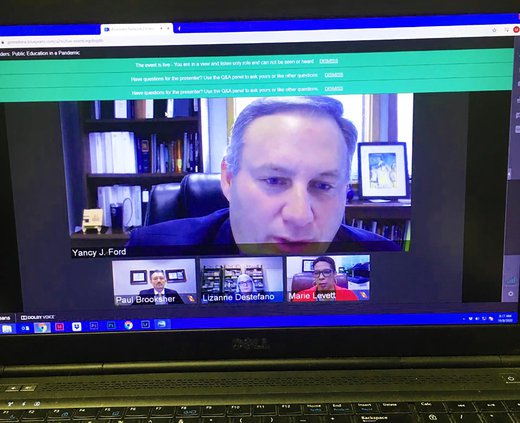RINCON — There is more than one way to skin a cat — and COVID-19.
Three area superintendents, including Effingham County’s Dr. Yancy Ford, recently discussed the unique ways their school districts are educating students while combatting the contagious disease. They were participants in Thursday’s Georgia Tech-Savannah Learners and Leaders session, a free online event entitled “Public Education in a Pandemic.”
Georgia Tech’s Dr. Lizanne DeStefano served as the moderator. She is a professor of psychology and the executive director of the Center for Education Integrating Science, Mathematics & Computing (CEISMC).
“What we would like to do this morning is sort of understand the considerations that go around planning education under these very, very unusual circumstances ...,” she said.
Dr. Paul Brooksher of the Bryan County School District was the first superintendent to speak. He started his education career as a paraprofessional.
“Right now, the current status in Bryan County Schools is a good one,” he said.
Aug. 17 was the first day of school in Bryan County. It offers face-to-face instruction for 7,280 students and virtual learning for more than 2,000 others.
“We gave parents a choice,” Brooksher said. “We offer different e-learning models at all of our levels — our (grades) K-5, our 6-8 and our 9-12. Each one of them kind of has a different delivery model from an e-learning standpoint but we are extremely focused on the ‘synchronous’ model.
“We really believe that live instruction has the most positive impact on student learning.”
Bryan County has developed a “hardship process” for students to change their method of receiving instruction.
All Bryan County students who receive face-to-face instruction are required to wear masks.
“We believe that has a significant positive impact on our COVID-19 numbers,” Brooksher said.
Bryan County makes its COVID-19 statistics available on its website for the prior week each Monday. Four students and three teachers tested positive from Oct. 5-9.
“Not knocking on wood right but, as of right now, every case that we have investigated, we haven’t seen any spread from students,” Brooksher said. “Every COVID-19 situation that we are dealing with is from home exposure. That’s a great thing.”
Superintendent Dr. M. Ann Levett the recapped the COVID-19 situation in the Savannah-Chatham County Public School System.
“Things are going well,” she said. “You have seen from press accounts that we took another step (Oct. 7).”
The “step” was opening the schools for face-to-face instruction. They have been offering only online learning since Aug. 19.
Levett said her district, which has 37,000 students, has been dealing with COVID-19 since the end of January when it learned a student had visited China.
“That started our communication and intimate knowledge of the coronavirus,” she said.
Gov. Brian Kemp ordered all Georgia public schools to close in March, forcing all students to learn virtually. Schools didn’t reopen until the start of the current school year.
“We still have a significant number of our students and staff who are on virtual and it seems to be working out,” Levett said.
The district was able to round up enough computers for every student.
“... including our pre-K babies,” Levett said.
Savannah-Chatham County is using a “hybrid” method of instruction. Face-to-face instruction is offered two days a week to a limited number of students.
On Oct. 26, more students will be afforded the opportunity for face-to-face instruction.
“We are also seeing great progress in our community in terms of the (COVID-19) transmission index,” Levett said. “It is continuing to go down and that’s a good thing. It also means less restrictions for us, so we are moving right along.”
Effingham County’s COVID-19 adjustments are mostly in tune with those in Bryan County.
“I can truly say that we’ve had some success in Effingham and that is a testament to the other superintendents in our area and throughout our state that have been more than willing to offer their expertise to me,” said Ford, named the successor to the retired Dr. Randy Shearouse near the start of the pandemic.
Ford said his district made its COVID-19 plans after a June survey of parents. He said they were equally split between preferring face-to-face instruction and a virtual option.
Just under 10,000 of the district’s students eventually opted for the traditional route by the Aug. 5 start of school.
“It’s been a good start,” Ford said. “We have been very fortunate that we haven’t had a large spread (of COVID-19) in any school. We’ve had some hot spots as most schools have.
“We may have a week that’s a little better than others or a little worse than others but we have been able to keep schools open.”
Ford indicated that most of his district’s cases also originated outside school.
The superintendent said 1,000 students who originally opted for virtual learning will return to school for the second nine weeks.





